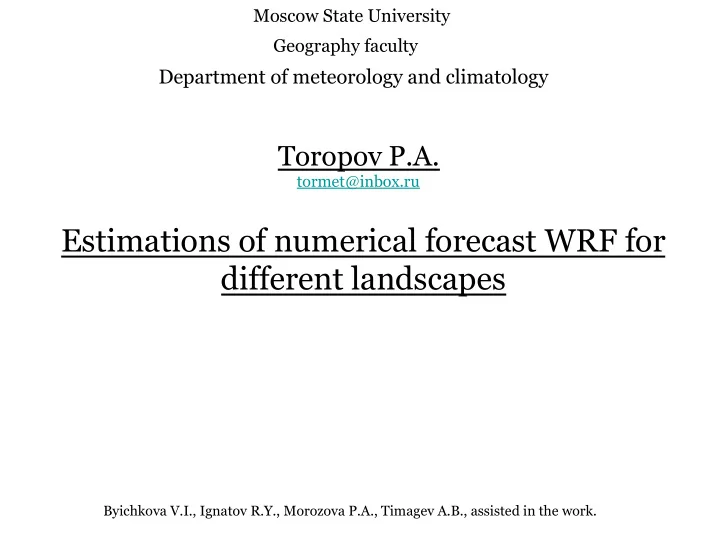

Moscow State University Geography faculty Department of meteorology and climatology Toropov P.A. tormet@inbox.ru Estimations of numerical forecast WRF for different landscapes Byichkova V.I., Ignatov R.Y., Morozova P.A., Timagev A.B., assisted in the work.
Weather Research & Forecasting Model (WRF) National Center for Atmospheric Research
List of problems which are solved using the WRF model 1. Simulation of the hydrological regime of reservoirs in Central Russia 2. Simulation of North-East by the example of Novorossiysk 3. Simulation of precipitation in mountainous regions in the Caucasus
1. Modeling of the reservoirs hydrological regime Objective is - Analysis of the possibility of using the WRF model as a source of primary fields for the model heat and mass transfer in the reservoirs Integration domain Spase step 2 km, Initial conditions – FNL analysis 1ºx1º Forecasts were compared with the station data ( 51 stations). 3 series of forecasts for 5.5 days, from 12:00 25.06.2008, 30.06.2008 and 05.07.2008 has been realized.
Estimation of meteorological forecast Estimates averaged for 3 series of experiments Precipitation Mean error Standart error 1 Day 2.5 0.5 2 Day 2.1 0.9 3 Day 4.5 0.7 4 Day 4.3 2.3 5 Day 4.2 0.4 Temperature Mean Standart error Wind 10m Mean Standart error 2m error error 1 Day 1.0 1.4 1 Day 1.4 1.4 2 Day 1.0 1.4 2 Day 1.1 1.3 3 Day 1.2 1.5 3 Day 1.2 1.6 4 Day 1.1 1.4 4 Day 1.0 1.2 5 Day 1.1 1.5 5 Day 1.3 1.4
Hydrological calculations A layer of runoff in the watershed of Mozhaisk reservoir (in mm) A layer of runoff within the Moscow river basin Date Forecast (mm) Observations (mm) Difference 8 Series 1 2.7 2.7 0.0 7 Forecast (26.06-30.06) 6 5 Series 2 2.9 3.3 0.4 4 (01.07-05.07) Observation 3 Series 3 3.5 7.0 3.5 2 (06.07-10.07) 1 0 Middle 3 4.3 1.3 1 2 3 4 5
Conclusions of the first part • successful reproduction fields of temperature and wind in the forecast for 5 days in the ETR; • opportunity to use forecast to predict the level of reservoirs at intermediate values of the river flow; • the ability of WRF model to reproduce the mesoscale features of the meteorological fields over waters
Modeling of North-East by the example of Novorossiysk Integration domain Automatic stations Spase step 1 km, Initial conditions – FNL analysis 1ºx1º Forecasts were compared with the station data (2 WMO stations and 4 automatic stations). The numerical value of forecasts obtained for 2005 2006 2008 and 2009 Years
Example of forecast of strong wind and low temperatures caused by North-East at 12:00 4 feb 2010 at 12:00 5 feb 2010
Example of forecast of strong wind and low temperatures in at the points where automatic station (AMC) were installed. 4-6 Feb. 2006 10 Temperature 8 6 Correlation – 0.87 4 Температура , С 2 0 4 5 6 -2 -4 -6 АМС WRF 12 Wind speed 10 Correlation – 0.92 8 Скорость ветра , м / с 6 4 2 0 4 5 6 АМС WRF
Estimation of temperature and wind speed forecast describing the Nord-East Mean error Max error Standard error Temperature 2005 1,6 2,9 1,7 Temperature 2006 1,8 3,2 1,2 Temperature 2008 1,9 3,1 0,7 Temperature 2010 0,4 2,1 0,9 Wind speed 2005 1,2 2,7 1,6 Wind speed 2006 1,0 2,6 1,2 Wind speed 2008 1,1 2,8 0,6 Wind speed 2010 1,8 6,1 2,9
Hydraulic theory of Nord-East wind h o V 1=2 V o V o H o V 1 h 1 The wind speed is increased by 2 times after the mountain
Conclusions of the second part • The WRF model adequately reproduces the spatial and temporal distribution of meteorological elements in Nord-East, reflecting a temporary course of time of its occurrence, expressed in the temperature decreasing and wind speed increasing. • Wind field, obtained in the course of numerical experiments are fully consistent with the hydraulic theory of Nord-East. • Forecasts can be used to the prediction of dangerous appearances .
Modeling of precipitation in mountainous regions in the Greater Caucasus 3 2 6 5 1 4 Map of the rainmeters
Integration domain Spase step 1 km, The numerical values were received for August 2008 • The model reproduced the presence of precipitation – 100% • The model reproduced the lack of precipitation - 82% • WRF caught the spatial structure of precipitation
Main conclusions • Opportunity to use forecast to predict the level of reservoirs at intermediate values of the river flow was revealed; • The WRF model adequately reproduces the spatial and temporal distribution of meteorological elements in Nord- East, reflecting a temporary course of time of its occurrence, expressed in the temperature decreasing and wind speed increasing. • The model is able to reproduce the spatial structure of precipitation in mountainous areas
Thank you for your attention!
Recommend
More recommend